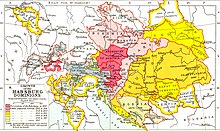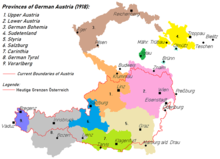Austrians
  
  | |
| Regions with significant populations | |
|---|---|
| 800,000 | |
| 300,000[1] | |
| 230,000 | |
| 80,000 | |
| 24,000 | |
| 20,204 | |
| 15,000 | |
| 11,000 | |
| 9,300 | |
| 6,300 | |
| 5,400 | |
| 5,400 | |
| 4,000[2] | |
| 3,000 | |
| 1,800 | |
| 1,300 | |
| Languages | |
| German (Austrian German)[3] regional also: Croatian, Hungarian, Slovene | |
| Religion | |
| Roman Catholic ca. 75%, Protestant ca. 5%, other or no religion (ca. 20%) | |
| Related ethnic groups | |
| Germanic peoples, Czechs,[4] Slovaks, Hungarians, Slovenes and Croatians[5] | |
Austrians (German: Österreicher) are a nation[9] and an ethnic group[2] originating from the Republic of Austria and its historical predecessor states who share a common Austrian culture and Austrian descent. Due to their common history and belonging to the Holy Roman Empire until 1806, German-speaking Austrians were historically regarded as Germans, but after the founding of a German national state, the German Empire in 1871, and after the events of World War II and Nazism, this has fallen out of fashion and is sometimes considered offensive.
Austrians have also been defined by their national citizenship, which had, in the course of Austrian history, varying relations to the above, for example referring to a native German-speaker of the one-time Habsburg empire, or in a wider sense to any citizen of any of the various lands of that empire that did not form the Hungarian half of Austria-Hungary. In the latter sense, the definition included many ethnic minorities and speakers of up to twelve different languages.
Etymology
The English word Austrian is a derivative of the proper name Austria, which comes, via Medieval Latin, from the Old High German name Ostarrîchi, meaning "Eastern Realm". The same word is the source for the New High German word Österreich (Ost- "East] and Reich - "Empire" or realm, among other meanings..
The oldest known mention in writing of Ostarrîchi dates from the year 996, when it was used to refer to a region in what is now Lower Austria.
A Latin translation for Ostarrîchi, Marcha Orientalis, was itself retranslated into German during the 19th century as Ostmark, which was the official name applied to modern-day Austria for part of the time that it was incorporated into Nazi Germany from 1938 to 1945. Ostmark itself does not appear to have been used during the Middle Ages.
History
Middle Ages to Early Modern period
The name Österreich appears in the 10th century, as Old High German Ostarrîchi, in reference to the March of Austria.
In 1278 the territory, by then corresponding roughly to what are now Upper and Lower Austria, passed to the House of Habsburg, with whose history it became closely associated until the early 20th century. Within a century the Habsburgs had added Carinthia, Styria, Carniola, and Tyrol to their rule, thus effectively controlling most of the territory of the modern Republic of Austria. Being ruled from the Duchy of Austria, the name of the duchy came to be informally applied to all these territories collectively.
The Habsburgs greatly increased their political prestige and power with the acquisition of the lands of the crowns of Hungary and Bohemia in 1526. Hungary was more successful at retaining its cultural identity than Bohemia, which underwent a period of intense German colonisation, coupled with Germanization. However, the longer history under rule from Vienna, and some common German-speaking identity in lands such as Carinthia, Styria, or Tyrol, created a sense of Austrian identity.
Although not formally a united state, the lands ruled by the Habsburgs would sometimes be known, at least to outsiders, by the name Austria. In reality they remained a disparate range of semi-autonomous states, most of which were part of the complex network of states that was the Holy Roman Empire (the imperial institutions of which were themselves controlled for much of their later existence by the Habsburgs). However, the second half of the 18th century saw an increasingly centralised state begin to develop under the regency of Maria Theresa of Austria and her son Joseph II.

After the French Revolution and the rise of Napoleon, the emperor Franz II formally founded the Austrian Empire in 1804 and became as Franz I the first Austrian emperor. For the first time the citizens of the various territories were now citizens of the one same state, while the other German-speaking states still cultivated their Kleinstaaterei and didn't succeed in forming a homogenous empire before 1871 when the German Empire was founded.
A further major change resulted from a reorganisation of the empire in 1867 into a dual monarchy, with the Kingdom of Hungary gaining a considerable amount of political autonomy as one of the two halves. The other half remained a patchwork of states, broadly coterminous with the modern-day Austria, the Czech Republic, Slovenia, and parts of Poland, Ukraine, Italy, and Croatia. These non-Hungarian lands, formally known as "the Kingdoms and States Represented in the Imperial Council" were sometimes known as Austria, for want of a better name. An alternative label in this context is Cisleithania.
Modern ethnogenesis
While the name Ostarrîchi has medieval origins, and the Modern Latin Austria is coined for Habsburg Austria, there was no Austrian national or ethnic identity prior to the 19th century.
19th-century nationalism
The Austrian lands had also been members of the Habsburg-dominated German Confederation since 1815. This split political personality also reflected a cultural uncertainty as to whether the German-speaking peoples under Austrian rule were Austrian, or German, or both. The developing sense of a German nationality had been accelerated massively as a consequence of the political turmoil and wars that engulfed Central Europe following the French Revolution and the rise to power of Napoleon Bonaparte. Although the years of peace after Napoleon's fall quickly saw German nationalism largely pushed out of the public political arena, the Revolutions of 1848 established it as a significant political issue for a period of over twenty years. Political debate centred on the nature of a possible future German state to replace the Confederation, and part of that debate concerned the issue of whether or not the Austrian lands had a place in the Germany polity.
Habsburg influence over the German Confederation was rivalled by the increasingly powerful Prussian state. Political manoeuvering by the Prussian chancellor Otto von Bismarck resulted in military defeat of the Austrians in 1866 and the collapse of the Confederation, both effectively ending any future Austrian influence on German political events. The so-called Franco-Prussian War and the establishment of a German Empire, headed by Prussia and pointedly excluding any of the Austrian lands, diminished the influence of pan-Germanism in the Habsburg territories, and worked to reinforce the sense of a distinctively Austrian identity as the state turned away from Germany and turned its gaze towards the Balkan Peninsula.
The 20th century

The last year of World War I saw the collapse of Habsburg authority throughout an increasingly greater part of its empire, and the military surrender in November 1918 finally brought with it the abdication of the last emperor. The creation of the Czecho-Slovak and South Slav states, full independence for a rump Hungary, and the post-war treaties imposed by the victorious Allies combined to see the newly-established Austrian republic both with the boundaries it has today, and a largely homogeneous German-speaking population. However, German-speaking communities were also left scattered throughout the other new states, as well as in the southern part of Tyrol which now found itself part of Italy.
Initially the republic took the name German Austria, reflecting the republic being the German-speaking part of the old Austria and showing the popular desire to unite with the new German republic. The western province Vorarlberg however preferred unification with Switzerland[10]. These hopes were to be dashed by the Treaty of Saint-Germain in 1919, and the new state changed its name to Republic of Austria on 21 October 1919.
Desire for unity with Germany was motivated both by a sense of common national identity, and also by a fear that the new state, stripped of its one-time imperial possessions, and surrounded by potentially hostile nation-states, would not be economically viable. Austrian identity emerged to some degree during the First Republic, and although Austria was still considered part of the "German Nation" by most, Austrian patriotism was encouraged by the anti-Nazi/anti-Socialist clerico-authoritarianist state ideology known as Austrofascism from 1934-38.

By 1938, with Nazi governments in control of both Berlin and Vienna, the country was annexed to Germany (Anschluss) as Ostmark. In 1942 the name was changed to the Danubian and Alpine Districts, thus eradicating any links with an Austrian national past.
Since large portions of Austrian society either actively or tacitly supported the Nazi regime, the Allied forces treated Austria as a belligerent party in the war and maintained occupation of it after the Nazi capitulation. On the other hand, the Moscow Declaration labeled Austria as a free and democratic society before the war, and considered its capture an act of liberation.
The Austrian resistance to the Nazi rule started with the Anschluss in 1938. Historians estimate that there were about 10,000 members of resistance facing 700,000 NSDAP members in Austria.[11] The sign of the Austrian resistance was O5, where the 5 stands for E and OE is the abbreviation of Österreich with Ö as OE.
Post World War II
The end of World War II in 1945 saw the re-establishment of an independent Austria, although the Allied Powers remained in occupation until 1955, when the Second Republic was founded.

The national concept that developed before and during annexation emerged strongly in the postwar era. Austrians developed a self-image unambiguously separate from its German neighbour, basing itself on cultural achievements of the past, the Moscow Declaration, geopolitical neutrality, language variation, Habsburg legacy (sans monarchism), and the historical separation of the Austrian and German empires in the 19th century.
Unlike in the early 19th century, in 1987 only 6 percent of the Austrians identified themselves as "Germans".[12]. Indeed, being (mis)identified as one can cause resentment. Today over 80 percent of the Austrians see themselves as an independent nation.[13][14] The logic of the existence of an independent Austrian state is no longer questioned as it was in the early years of its republican existence.
Austria's multicultural history and geographical location has resulted in post-Soviet era immigration from Slovenia, the Czech Republic, Hungary, Slovakia, Romania, and Poland. As with neighbouring Germany, there has also been immigration from Turkey and former Yugoslav states such as Croatia and Serbia.
Culture
Culture on the territory of what is today Austria can be traced back to around 1050 B.C. with the Hallstatt and La Tène cultures. However, a culture of Austria as we know it today began to take shape when the Austrian lands were part of the Holy Roman Empire, with the Privilegium Minus of 1156, which elevated Austria to the status of a Duchy, marking an important step in its development. Austrian culture has largely been influenced by its neighbours, Italy, Germany, Hungary and Bohemia and the other Czech lands.
Language
Austrian German is a variety of the German language spoken in Austria. There is no unitary Austrian language, but a variety of High German dialects are spoken. Besides the Germanic languages discussed here, minority languages such as Slovene, Croatian, and Hungarian are spoken in parts of the country.
Austro-Bavarian is widely spoken in Austria. The latter dialects are considered to belong either to the Central Austro-Bavarian or Southern Austro-Bavarian subgroups, with the latter encompassing the languages of the Tyrol, Carinthia, and Styria and the former including the dialects of Vienna, Upper Austria, and Lower Austria. The dialect spoken in Vorarlberg is more closely related to Swiss German than it is to other Austrian dialects, so Austrians from outside Vorarlberg may have difficulties understanding it.
While strong forms of the various dialects are not normally comprehensible to most German speakers, there is virtually no communication barrier along the border between Austria and Germany, since people on both sides of the border speak very similarly. The Central Austro-Bavarian dialects are more intelligible to speakers of Standard German than the Southern Austro-Bavarian dialects of Tyrol. Viennese, the Austro-Bavarian dialect of Vienna, is most frequently used in Germany for impersonations of the typical inhabitant of Austria.
Cuisine
Austrian cuisine, which is often incorrectly equated with Viennese cuisine, is derived from the cuisine of the Austro-Hungarian Empire. In addition to native regional traditions it has been influenced above all by Hungarian, Czech, Jewish, and Italian cuisines, from which both dishes and methods of food preparation have often been borrowed. Goulash is one example of this. Austrian cuisine is known primarily in the rest of the world for its pastries and sweets. In recent times a new regional cuisine has also developed which is centred on regional produce and employs modern and easy methods of preparation.[citation needed]
See also
- Austrian American
- Austrian Argentine
- Austrian Brazilian
- Austro-Bavarian
- List of Austrians
- Demographics of Austria
- Germanic peoples
- Carinthian Slovenes
- Burgenland Croats
External links
Notes
[17] [18] [19][20][21][22][23][24][25]
References and sources
- ^ http://www.provincia.bz.it/downloads/Siz_2006-eng.pdf
- ^ http://www.hausarbeiten.de/faecher/vorschau/106879.html
- ^ US Department of State Austria
- ^ http://www.da-vienna.ac.at/userfiles/directorscorner/apa1.pdf
- ^ The sound of success, Economist, Nov 22nd 2007
- ^ According to the CIA World Factbook - Austria - People: Ethnic Groups the percentage of ethnic Austrians in Austria is 91.1% meaning there are 7,463,714 ethnic Austrians in Austria.
- ^ Census 2000: Ancestry - 730,336 people claimed Austrian descent; see also Austrian-Americans
- ^ Statistics Canada 2001: Ethnic Origins - 147,585 claimed to be of Austrian ethnic origin.
- ^ http://www.photoglobe.info/ebooks/austria/cstudies_austria_0070.html
- ^ [ http://www.vol.at/chronik/viewpage.aspx?id=121&left=suche&viewtype=artikel.]
- ^ Dokumentationsarchiev des österreichischen Widerstands
- ^ [1] Development of the Austrian identity .
- ^ http://derstandard.at/?url=/?id=3261105
- ^ Austria. Library of Congress Country Studies, 2004. Accessed 1 October 2006.
- ^ https://www.cia.gov/library/publications/the-world-factbook/geos/au.html#People The CIA World Factbook
- ^ http://encarta.msn.com/encyclopedia_761575697_2/Austria.html#s7 MSN Encarta. Archived 2009-10-31.
- ^ http://original.britannica.com/eb/article-33395/Austria
- ^ http://www.state.gov/r/pa/ei/bgn/3165.htm
- ^ http://eumc.europa.eu/eumc/index.php?fuseaction=content.dsp_cat_content&contentid=44f6f724ba916&catid=4434e55adcab7&search=1&frmsearch=ethnic%20austrians&lang=EN The European Monitoring Center on Racism and Xenophobia
- ^ Literature:
- Franz A. J. Szabo: Austrian Immigration to Canada. Pg. 41 et seq.
- Alfred Connor Browman: Zones of Strain: A Memoir of the Early Cold War. Pg. 73
- Ilija Sutalo: Croatians in Austria. Pg. 21
- Donald G. Daviau, Herbert Arlt: Geschichte der österreichischen Literatur. Pg. 318
- Deirdre N. McCloskey: The Bourgeois Virtues - ethnics for an age of commerce. Pg. 190
- Bruce M. Mitchell, Robert E. Salsbury: Multicultural Education - An international guiede to research, policies and programs. Pg. 19
- ^ http://www.ihs.ac.at/publications/eco/es-170.pdf Institute for Higher Studies (IHS)
- ^ http://www2.gov.si/up-rs/2002-2007/jd-ang.nsf/dokumentiweb/FC8720F0466FFA64C1256F95002D0082?OpenDocument The President of the Republic of Slovenia
- ^ http://news.bbc.co.uk/1/hi/world/europe/638999.stm The BBC
- ^ http://www.chinese-embassy.info/europe/aut.htm The Chinese Embassy in Austria
- ^ http://www.uni-regensburg.de/Fakultaeten/phil_Fak_IV/Bohemicum/IK/Sprachmanagement-Theorie.pdf A study from the University of Regensburg


